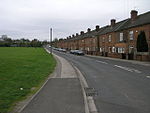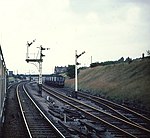Woodhouse Mill railway station

Woodhouse Mill railway station was opened in 1840 by the North Midland Railway on its line between Rotherham Masborough and Chesterfield. It was situated to the south of the main A57 road shortly after this left the City of Sheffield and served Woodhouse Mill, near Sheffield, Orgreave, Fence and (Aston cum Aughton), all within Rotherham, South Yorkshire. It may initially have been simply a halt, but the Midland Railway installed an island platform with a timber and brick booking office at its centre. Nearby was Orgreave Coke Works and Fence Colliery. It closed in 1953.The station was located between that at Treeton and the original North Midland station at Beighton. The line is still in use today but has been a freight only route since July 1954, although it is very occasionally used as a diversionary route and by excursions not calling at Sheffield. It serves as a bypass line which keeps freight trains away from the congested lines through central Sheffield.
Excerpt from the Wikipedia article Woodhouse Mill railway station (License: CC BY-SA 3.0, Authors, Images).Woodhouse Mill railway station
Retford Road,
Geographical coordinates (GPS) Address External links Nearby Places Show on map
Geographical coordinates (GPS)
| Latitude | Longitude |
|---|---|
| N 53.36808 ° | E -1.34637 ° |
Address
Woodhouse Mill
Retford Road
S13 9WG , Aston cum Aughton
England, United Kingdom
Open on Google Maps





